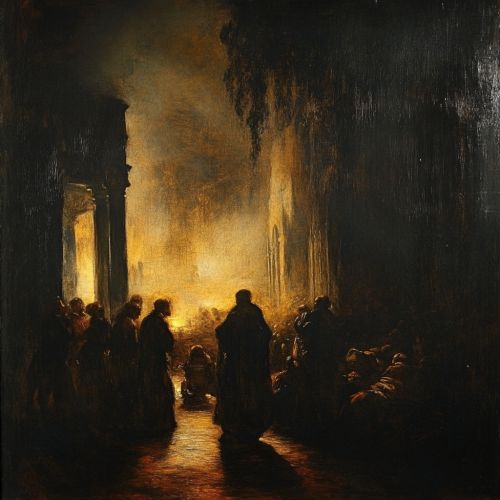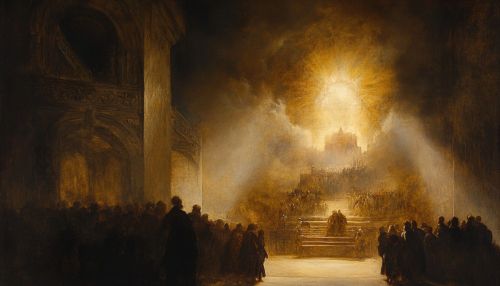Rembrandt van Rijn: Difference between revisions
(Created page with "== Early Life and Education == Rembrandt Harmenszoon van Rijn was born on July 15, 1606, in Leiden, a city in the Dutch Republic, now the Netherlands. He was the ninth child of Harmen Gerritszoon van Rijn, a miller, and Neeltgen Willemsdochter van Zuytbrouck. Rembrandt's family was relatively well-off, which allowed him to receive a good education. He attended the Latin School in Leiden, where he studied classical literature and the Bible, which would later influence his...") |
No edit summary |
||
| Line 8: | Line 8: | ||
Rembrandt returned to Leiden in 1625 and opened his own studio. His early works, such as "The Stoning of Saint Stephen" (1625), show the influence of Lastman and the [[Italian Renaissance|Italian Renaissance]] artists. During this period, Rembrandt focused on biblical and historical subjects, experimenting with light and shadow to create a sense of depth and drama. | Rembrandt returned to Leiden in 1625 and opened his own studio. His early works, such as "The Stoning of Saint Stephen" (1625), show the influence of Lastman and the [[Italian Renaissance|Italian Renaissance]] artists. During this period, Rembrandt focused on biblical and historical subjects, experimenting with light and shadow to create a sense of depth and drama. | ||
[[Image:Detail-98013.jpg|thumb|center|An early painting by Rembrandt depicting a biblical scene with dramatic lighting.|class=only_on_mobile]] | |||
[[Image:Detail-98014.jpg|thumb|center|An early painting by Rembrandt depicting a biblical scene with dramatic lighting.|class=only_on_desktop]] | |||
=== Move to Amsterdam === | === Move to Amsterdam === | ||
Latest revision as of 21:32, 19 September 2024
Early Life and Education
Rembrandt Harmenszoon van Rijn was born on July 15, 1606, in Leiden, a city in the Dutch Republic, now the Netherlands. He was the ninth child of Harmen Gerritszoon van Rijn, a miller, and Neeltgen Willemsdochter van Zuytbrouck. Rembrandt's family was relatively well-off, which allowed him to receive a good education. He attended the Latin School in Leiden, where he studied classical literature and the Bible, which would later influence his work.
At the age of 14, Rembrandt enrolled at the University of Leiden, but he left after a few months to pursue his passion for art. He apprenticed with the Leiden painter Jacob van Swanenburgh for three years, learning the basics of painting and drawing. In 1624, Rembrandt moved to Amsterdam to study under Pieter Lastman, a prominent history painter. Lastman introduced Rembrandt to the techniques of Caravaggesque realism and the use of dramatic lighting, which would become hallmarks of his style.
Artistic Career
Early Works
Rembrandt returned to Leiden in 1625 and opened his own studio. His early works, such as "The Stoning of Saint Stephen" (1625), show the influence of Lastman and the Italian Renaissance artists. During this period, Rembrandt focused on biblical and historical subjects, experimenting with light and shadow to create a sense of depth and drama.


Move to Amsterdam
In 1631, Rembrandt moved to Amsterdam, the commercial and artistic hub of the Dutch Republic. He quickly gained a reputation as a talented portrait painter, receiving commissions from wealthy merchants and prominent citizens. One of his most famous early works from this period is "The Anatomy Lesson of Dr. Nicolaes Tulp" (1632), which showcases his skill in capturing the likeness and character of his subjects.
Mature Period
During the 1630s and 1640s, Rembrandt's style evolved, becoming more refined and expressive. He began to use a broader range of colors and textures, and his compositions became more complex. Notable works from this period include "The Night Watch" (1642), a large group portrait of the Amsterdam militia, and "The Jewish Bride" (c. 1665), a tender depiction of a couple.
Rembrandt also produced a significant number of etchings during this time, which were highly sought after by collectors. His etchings often depicted biblical scenes, landscapes, and portraits, showcasing his mastery of line and shading.
Personal Life
In 1634, Rembrandt married Saskia van Uylenburgh, the cousin of his art dealer, Hendrick van Uylenburgh. The couple had four children, but only one, Titus, survived infancy. Saskia's death in 1642 deeply affected Rembrandt, and his work from this period reflects a more introspective and melancholic tone.
After Saskia's death, Rembrandt entered into a relationship with his housekeeper, Geertje Dircx, but their relationship ended acrimoniously. He later formed a partnership with Hendrickje Stoffels, who became his common-law wife and the mother of his daughter, Cornelia.
Later Years and Financial Troubles
Despite his success as an artist, Rembrandt faced financial difficulties in the latter part of his life. He lived beyond his means, purchasing expensive art, antiques, and other luxuries. In 1656, he declared bankruptcy and was forced to sell his house and possessions.
Rembrandt continued to paint and etch during this period, producing some of his most profound and introspective works. His later paintings, such as "The Return of the Prodigal Son" (c. 1669) and "Self-Portrait with Two Circles" (c. 1665-1669), are characterized by their emotional depth and masterful use of light and shadow.
Artistic Techniques and Innovations
Rembrandt is renowned for his innovative use of chiaroscuro, the contrast between light and dark, to create a sense of volume and depth in his paintings. He often used a limited palette of colors, relying on subtle variations in tone to achieve a rich, luminous effect.
His technique of impasto, where paint is applied thickly to create texture, added a tactile quality to his work. Rembrandt's brushwork varied from fine, detailed strokes to broad, expressive sweeps, giving his paintings a dynamic and lively appearance.
Rembrandt was also a master of portraiture, capturing the individuality and inner life of his subjects with remarkable sensitivity. His self-portraits, which span his entire career, offer a unique insight into his personal and artistic development.
Legacy
Rembrandt's influence on the art world is immense. His innovative techniques and profound understanding of human emotion have inspired countless artists, from his contemporaries to modern painters. His works are held in major museums and collections worldwide, including the Rijksmuseum in Amsterdam, the Louvre in Paris, and the National Gallery in London.
